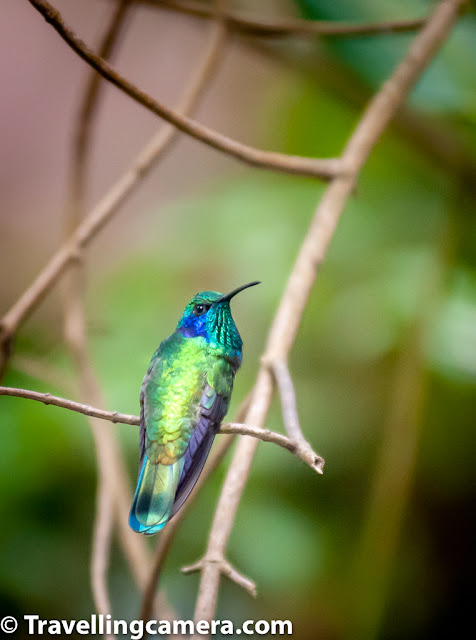Ever since I became aware of their existence, I have been fascinated by hummingbirds. They were to me like Aurora Borealis, something I knew I couldn't find in India, but still would keep looking for them. Yes, I was crazy that way. Ever since I learned about Aurora, I would keep looking at the sky in hope that it would one day break the barrier and burst out into the Indian sky as well. However, it hasn't done that so far.
Similarly in case of hummingbirds, I kept hoping I would one day see a hummingbird. Like almost everyone else, when I first saw a sunbird, I thought it was a hummingbird. It took me a while to accept that one can only find Hummingbirds in the Americas and sunbirds are only distantly related to them.
Anyway, Hummingbirds are our bird of the month of April and there's a very good reason for that. The month of April signifies the opportunity to refresh your outlook. In India, the financial year ends in with March and definitely involves frantic activities to put your financial affairs in order and to balance the accounts. After March, April offers an opportunity to adopt a new outlook. April is the time to shed your load, step back, introspect, and then step right back in. An instinct that the hummingbirds are born with.
The fact is that hummingbirds are only found in the Western Hemisphere. If you see a hummingbird-like creature in the Eastern Hemisphere, it is most likely a sunbird. Like Hummingbirds, sunbirds are tiny, pretty, and have pointed beaks for feeding on nectar. But apart from these similarities, both these birds are fundamentally different. While hummingbirds are closer to swifts, sunbirds are closer to crows. Hummingbirds hover over flowers to sip on nectar, whereas sunbirds like to perch close to the flowers to consume the nectar.
There are 341 known species of hummingbirds in the world. The smallest of these is the Bee Hummingbird, which is about 5-6 cm in length and weighs about 1.5-2.5 grams. This hummingbird is found in Cuba and is the smallest bird in the world. The largest hummingbird is the Giant hummingbird, which can reach a length of about 23cm and can weigh up to 24 grams. This bird is found on the eastern coast of South America. The Bee Hummingbird flaps its wings at the rate of 80 beats per second. In comparison, the Giant Hummingbird hovers at the rate of 15 beats per second. The larger the hummingbird, the more energy it consumes to hover.
The most number of hummingbirds we saw were in Cost Rica. The country is home to over 50 different species of Hummingbirds, and we were fortunate enough to see about 15 of them. We saw hummingbirds around Irazu Volcano near San Jose, in Monteverde, and at Papa Gayo peninsula.
The first Hummingbird we saw was a fiery-throated hummingbird on our way to Irazu Volcano. This medium-size hummingbird was perched on a branch right next to the road. We just happened to spot it from our moving cab, and the bird was generous enough to let us photograph it. A fiery-throated hummingbird can reach about 11cm in length and weigh about 5.6 grams.
We also happened to spot the tiny Volcano Hummingbird, though it was too small and quick for us to photograph. It is easy to mistake the Volcano Hummingbird for a wasp because of its size and speed. This hummingbird can reach the length of 7.5 cm and weight of about 3 grams. At lower elevations the Volcano Hummingbird is replaced by its relative, the Scintillant Hummingbird.
We also spotted several other hummingbirds, but clicking them was difficult. These are tiny creatures that move really fast and you need to have a really good lens and camera to do justice to these beautiful creatures. But we consider ourselves lucky that we were able to manage whatever we could. I still wish we had these birds in India as well, but I guess we would need to manage with our sunbirds :).











.jpg)
Comments